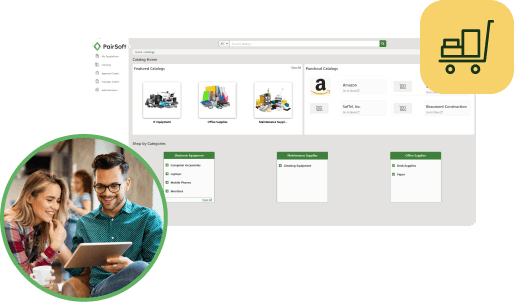
Janet Martin
Janet joined the PairSoft team upon its merger with Paramount Workplace, where she was also an integral part of the sales team for years. Janet resides in Michigan with her family.
View all posts by Janet MartinJanet Martin • May 5, 2022

No longer simply a cost center, procurement has become increasingly important to companies’ overall business strategy. Smart, progressive procurement strategies can not only save a company money, but they may even boost innovation and enhance the quality of products and business outcomes. But before we get ahead of ourselves, what are the basics of procurement? What action steps are involved? And importantly – what are the potential risks and pitfalls involved in each step? In this primer on procurement, we get at the basics and identify the risks involved, taking a high-level approach to the subject, with deeper dives into the topic to follow in upcoming posts.
The action: This first step in the procurement process may be obvious. Employees identify a need for a product or service and bring it to the attention of their supervisors, or directly to the purchasing department or agent.
The risks: Inefficiency is the main risk at this stage. It’s tremendously inefficient and wasteful to have individual employees across departments and locations independently researching the products and services they need. The majority of expenditures are routine purchases that can be anticipated and planned for. Office supplies are a prime example – it’s likely that you already have a trusted supplier for office supplies, and have identified various products from that vendor as preferred for use. It is much more efficient to provide employees with a catalog of products that have already been identified, and allow the employee to shop the catalog and select the items needed.
The action: Someone within the company needs to hold the authority to review and approve corporate expenditures. Is the request legitimate? Is there budget for it? Is the person requesting the product or service empowered to make the request? Might other departments, locations need the same thing? Is the product available at another location within the company?
The risks: Lack of control and inefficient processes are the risks here. The spending approval process can be a bottleneck in many companies. Often, the approver receives a paper form request, or an email note that quickly gets lost in the shuffle of daily tasks. How can you be sure there is budget available for the purchase, or that certain thresholds haven’t been exceeded? If you rely on different approvers based on variables such as who is doing the requesting, the vendor involved or the dollar amount in question, you risk further complicating and slowing the entire purchasing cycle.
The action: Once the need is identified, it’s up to someone to determine how to satisfy that need. From identifying the vendor to negotiating the best price, purchasing agents within the company establish a vendor relationship.
The risks: Will your staff perform due diligence in locating the best product at the best price? If it’s easy to shop pricing from multiple vendors, it’s more likely to happen. But who has time to phone or email to ask for quotations, and then track and analyze the results? And price isn’t the only concern: payment terms, minimum order quantities, delivery speed and quantity discounts should all be considered before determining the source.
The action: With product, pricing, terms and timing all agreed upon, someone, typically the purchasing agent, will place an order with the vendor.
The risks: A significant number of companies still place orders over the phone, many without even referencing a purchase order number. Tracking open orders is vital, but difficult without a robust purchase order tracking system. You need to know what’s on order and when it’s arriving, not only to keep the originator informed, but to be certain you don’t place duplicate or redundant orders inadvertently, or exceed your budget constraints.
The action: As the product or service is received in the company warehouse (or wherever the service is rendered) personnel will record the receipt of the goods or service. At this point, there may or may not be an invoice included, but our main concern in this step is establishing that the right goods in the right quantity have arrived.
The risks: If the receiver is not familiar with the products arriving, there’s a risk they may incorrectly record the receipt. We’re also concerned with delivering real-time information to stakeholders. Then there’s communicating the receipt to the requestor – or keeping the requestor informed if an item has not been received by the due date.
The action: An invoice may arrive with the product, or it may arrive at a later date, but when it does, it needs to be carefully matched to the original purchase order and to the receiving document to ensure that what is being billed for, was actually contracted for and received. Once approved, it is passed to the payables department for processing.
The risks: The main risk here is that the vendor’s invoice won’t match the purchase order’s terms and pricing. It’s vital to match the invoice to the order and receipt to avoid paying for items that have not yet been received. Conscientious companies will match the invoice to the purchase order (2-way matching) or to both the purchase order and the receiving document (3-way matching). However, rigorous matching protocols may not be necessary for all purchases. You can err by being so rigid that you spend hours researching just a few dollars of discrepancy.
The action: Record keeping isn’t really a separate step, it should be an integrated process that happens throughout every stage of the procurement cycle.
The risks: The risk here is that records are not kept, or are partially kept, or are not updated frequently, or don’t include an audit trail.
The procurement process is a necessary, vital function within every company. As with every business accounting function, procurement processing encompasses a series of stages and tasks, each with potential risks and pitfalls. Over the next several weeks, we’ll be exploring the procurement cycle in more detail, and will highlight ways you can bring efficiency and efficacy to the process, and minimizing the costly risks.
Talk to an expert today to uncover how your team’s procurement stacks up against the top performers in your sector.


